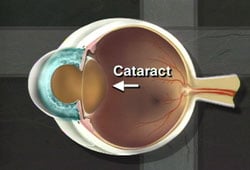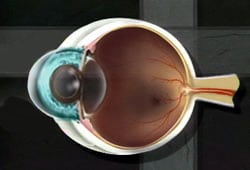
As we age, the lens inside our eye loses its ability to focus both near and far. Most vision correction procedures attempt to change the focusing power of the cornea. A refractive lens exchange, on the other hand, corrects nearsightedness or farsightedness by replacing the eye’s natural lens, which has the wrong power, with an artificial intra-ocular lens (IOL) implant that has the correct power for the eye.
A refractive lens exchange is a surgical procedure that uses the same successful techniques of modern cataract surgery. These surgical techniques have evolved and improved dramatically over the last 20 years. Cataract surgery is now the most common surgical procedure performed in medicine today.
The main difference between standard cataract surgery and a refractive lens exchange is that cataract surgery is primarily performed to remove a patient’s cataract that is obstructing and clouding their vision, while a refractive lens exchange is performed to reduce a person’s dependence on glasses or contact lenses. A refractive lens exchange can be combined with other procedures that treat astigmatism such as LRIs and AK.
A Refractive Lens Exchange Is For Those Who:
- want to reduce or eliminate their dependence on glasses or contacts
- may not be a good candidate for laser vision correction
- are 18+ years of age
- have no health issues affecting their eyes
Cataracts are a part of the normal aging process and if a person lives long enough chances are they will develop cataracts. People who have refractive lensectomy now, will not have to have cataract surgery in the future.

What To Expect On Surgery Day:
The refractive lens exchange procedure is performed on an outpatient basis. Only one eye will be treated at a time. After the eye is completely numbed with topical or local anesthesia, the eye’s natural lens will be gently vacuumed out through a tiny incision, about one eighth of an inch wide.
Next, the new, intra-ocular lens will be folded and inserted through the same micro-incision. It will then be unfolded and placed into the “capsular bag” that originally surrounded the natural lens.

This incision is “self-sealing” and usually requires no stitches. It remains tightly closed by the natural outward pressure within the eye. This type of incision heals fast and provides a much more comfortable recuperation.
AcrySof® ReSTOR® IOL
For most RLE patients, life without glasses or bifocals is something they either experienced before age 40, or they just dreamed about for most of their lives. But today, the AcrySof® ReSTOR® IOL is providing our patients with the ability to see clearly at all distances without dependence on bifocals or reading glasses.
Each of these presbyopia correcting IOLs is unique in its optical design and visual advantages. Which one is best for you depends on the unique characteristics of your eye as well as your lifestyle needs. After a thorough eye examination we will make a recommendation as to which of these revolutionary IOLs would be most advantageous for you.
If your eye has pre-existing astigmatism, your surgeon may elect to make micro-incisions in the cornea to reduce your astigmatism. These are called LRIs or limbal relaxing incisions.
You will go home soon after the surgery and relax for the rest of the day. Everyone heals somewhat differently but many patients report improvement in their vision almost immediately after the procedure. Most patients return to their normal activities within a day or two.
Realistic Expectations:
The decision to have a refractive lens exchange is an important one that only you can make. The goal of a refractive lens exchange is to reduce or eliminate your dependence on glasses or contact lenses. However, we cannot guarantee you will have the results you desire.
Serious complications with refractive lens exchange are extremely rare. It is a safe, effective and permanent procedure, but like any surgical procedure, it does have some risks. Going to an eye specialist experienced with the procedure can significantly minimize the risks involved with refractive lensectomy.
After a thorough eye exam, you and your doctor will determine if refractive lensectomy is an option for you. If you are a good candidate, you will be given additional information about the procedure that will allow you to make an informed decision about whether to proceed. Be sure you have all your questions answered to your satisfaction.
Alternatives To Refractive Lensectomy
A refractive lens exchange is not the only surgical procedure designed to correct nearsightedness. To learn about other procedures go to the surgical and laser vision correction procedures section of our Web Site. If you would like to learn more about vision correction procedures from sources other than our practice, we encourage you to link to a number of Web sites we feel provide factual and up-to-date information. You may also choose to make an appointment or request additional information to learn more about this exciting procedure.
We offer a number of finance options and affordable payment plans. It is easy to apply online and receive credit approval before you schedule an appointment.
Get In Touch With Us:
To learn more about Hattiesburg Eye Clinic and our services please call us at 601 268 5910 or toll-free at 800 624 8254 or schedule a consultation.


